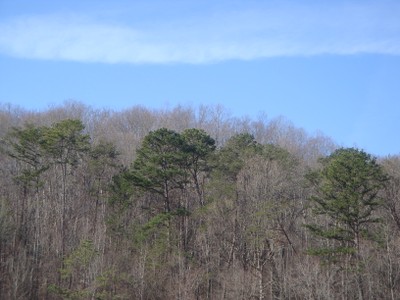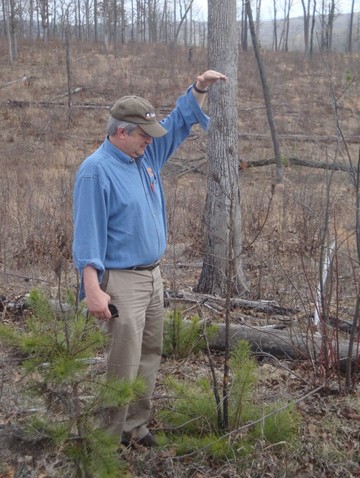Wayne K. Clatterbuck
Professor, Dept. of Forestry, Wildlife & Fisheries, University of Tennessee
Historically, before the advent of fire
control and Smokey Bear campaigns
in the 1950s, shortleaf pine-hardwood
forests (Fig. 1) were abundant on
average to poor productivity sites of the
Cumberland Plateau, foothills and side
slopes of the Blue Ridge Mountains,
and the Piedmont region. These forests
are defined as having pine basal areas
of 25 to 75% per unit area.6 Frequent
fire created seedbed conditions of
bare, mineral soil to allow successful
seed germination and seedling growth
and some control of understory and
midstory vegetation. Shortleaf pinehardwood
forest types have transitioned
to predominantly hardwood forests due
to natural succession, southern pine
beetle outbreaks, and the absence
of fire, which is often necessary to
naturally regenerate shortleaf pine.
Many of the former mixed stands do
not have a shortleaf pine seed source
to perpetuate the species. Thus, to
create these species mixtures, artificial
regeneration of shortleaf pine is
necessary through planting.
Shortleaf pine-hardwood mixtures
are attractive management options
for landowners compared to other
management practices such as pine
plantations and pine savannas which
tend to have high establishment and
maintenance costs and require large
acreages to be economically feasible.
Most private landowners who own less
than 50 to 100 acres of land have a
bias against pine plantations, whatever

- Figure 1: Example of a remnant shortleaf pine-hardwood site in Campbell County, Tennessee. Credit: Wayne Clatterbuck, University of Tennessee
the species, and pine-hardwood mixtures offer landowners more species
diversity and wildlife habitat options4 as well as wider markets for various
forest products.
Pine-hardwood mixtures are a transitional forest type that will eventually
succeed to longer-lived hardwoods.5 Without disturbance to allow the
shorter-lived pine to re-establish in more open canopies, the pine will
diminish. The disturbance, whether burning, harvesting or weather-related,
has to be timed with a good seed-producing year which occurs fairly
infrequently. Good shortleaf seed crops occur every 3 to 10 years3 and
often do not coincide with the disturbance event. Shortleaf pine seed do not
remain viable from one year to the next. Thus, if exposed mineral soil and
weather conditions are not favorable for seed germination when a good seed
year occurs, the site often becomes overgrown and not receptive for seed in
future years. The seed tree regeneration method for shortleaf pine often fails
because favorable seed years and disturbances do not coincide.

- Figure 2: One-year sprout growth of topkilled shortleaf pine seedlings after prescribed burning. Author notes height of the dead stem. Cumberland County, TN on the Cumberland Plateau. Credit: Wayne Clatterbuck, University of Tennessee
Shortleaf pine is one of the few pine species with the ability
to sprout from dormant buds located on a basal crook
when the stem is killed.2 Burning will allow resprouting (Fig.
2) from the basal crook which may give shortleaf pine a
growth advantage and a survival mechanism compared
to other species. However, most hardwoods also sprout
and can compete with shortleaf pine. The tradeoffs
between pine and hardwood establishment, growth and
development in mixed stands are poorly understood,
even though these stands were widespread before fire
suppression activities. Burning certainly had a role, but
how burning impacted the mixed composition of these
stands is not known.
Future Research Needs
Research, information and procedures in establishing
shortleaf pine-hardwood stands are inadequate, especially
when a shortleaf pine seed source is no longer available.
Thus, specific guidelines or recommendations based on
research are absent on how to establish these mixed
stands. A few of the questions that are being investigated
include:
1. What is shortleaf pine seedling survival rate with
prescribed fire? Does the time or season of the year
affect sprouting and survival? Preliminary results indicate
the survival rate of 1- to 3- year-old seedlings is 40 to 45
percent and that season of burning had little effect on
survival.1 These results suggest that if burning is used
to promote shortleaf pine seedling establishment, more
of than half of the seedlings die and thus planting rates
should be doubled to achieve the prescribed number of
seedlings.
2. What is the best site preparation method to establish
planted shortleaf pine among naturally regenerating
hardwood species: burning, herbicide, or combinations
of burning and herbicide? How does shortleaf pine grow
and develop compared to hardwood sprouts of various
species? Burning and herbicide treatments will have
different impacts on different hardwood species.
3. Is it possible to establish shortleaf pine seedlings not
only in even-aged stands with hardwoods, but in residual
hardwood stands that have an open overstory component,
i.e., creating a two-aged stand? How does shortleaf
pine establish and develop in such conditions? Twoaged
stands provide some overstory presence and mast
potential for wildlife while establishing both planted pine
and natural hardwood regeneration in overstory openings.
Although the answers to these questions at this time are
not available in the literature, historically these stands
were present and provided varied management scenarios
based on ownership objectives. One of the most common
scenarios was to have a mixed stand where the pine could
be harvested early to provide an intermediate income
leaving the hardwoods for longer rotations. However, the
opposite could also take place, harvesting the hardwood
for fiber markets and leaving the shortleaf pine for quality
sawlogs or poles. Mixed species gives landowners many
options, especially on marginal or cutover forest land that
is presently poorly stocked or with degraded residual trees
of limited value or habitat.
References
1Clabo, D.C. 2014. Shortleaf pine sprout production capability in
response to disturbances. M.S. Thesis, University of Tennessee,
Knoxville. 76 p.
2Guldin, J.M. 1986. Ecology of shortleaf pine. In: P.A. Murphy,
ed. Proceedings of Symposium on the Shortleaf Pine Ecosystem. 1986 March 31-April 2; Little Rock, AR. Arkansas Cooperative
Extension Service, Monticello, AR: 25-40.
3Lawson, W.R. 1990. Pinus echinata Mill. shortleaf pine.
In: Burns, R.M.; Honkala, B.H. (tech. cords.). Silvics of
North America: Vol. 1. Conifers. Agriculture Handbook 654,
Washington, DC: U.S. Dept. of Agriculture, Forest Service: 316-326.
4Masters, R.M. 2007. The importance of shortleaf pine for wildlife
and diversity in mixed oak-pine forests and in pine-grassland
woodlands. In: Kabrick, J.M., Dey, D.C., Gwaze, D. Eds. Shortleaf
Pine Restoration and Ecology of the Ozarks: Proceedings of a
Symposium. Gen. Tech. Rep. NRS-P-15. Newtown Square, PA:
U.S. Dept. of Agriculture, Forest Service, Northern Research
Station: 35-43.
5Olson, D.F., Jr., McAlpine, R.G. 1973. Oak-pine. In: Silvicultural
Systems for the Major Forest Types of the United States.
Agriculture Handbook 445. Washington, DC: U.S. Dept. of
Agriculture, Forest Service: 83-84.
6Sheffield, R.M., Birch, T.W., Leatherberry, E.C., McWilliams,
W.H. 1989. The pine-hardwood resource in the eastern United
States. In: Waldrop, T.A. ed. Proceedings of Pine-Hardwood
Mixtures: A Symposium on Management and Ecology of the
Type. Gen. Tech. Rep. SE-58. Asheville, NC: U.S. Dept. of
Agriculture, Forest Service, Southeastern Forest Experiment
Station: 9-19.
